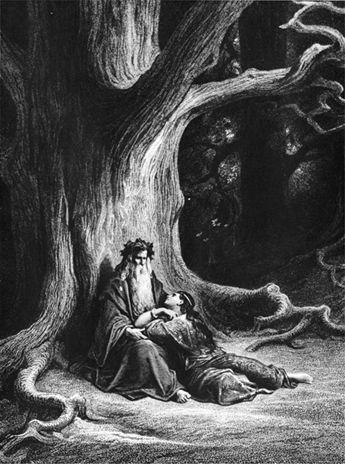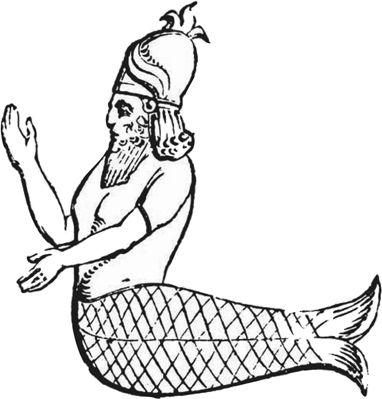The Sorcerer's Companion: A Guide to the Magical World of Harry Potter (54 page)
Read The Sorcerer's Companion: A Guide to the Magical World of Harry Potter Online
Authors: Allan Zola Kronzek,Elizabeth Kronzek

During the reign of Uther Pendragon, Merlin performed a feat that was even more remarkable. Uther had fallen in love with a married duchess named Ygerna. As a result, her husband Gorlois, the Duke of Cornwall, locked her up in a heavily guarded castle. But Merlin cast a spell to make Uther look exactly like Gorlois, allowing Uther to gain entrance to the castle. The guards were fooled, as was Ygerna. That night, Arthur, the heir to Uther’s throne and the future king of Britain, was conceived. Years later, after the real Gorlois was killed in battle, Ygerna and Uther married.

Merlin succumbs to Vivien’s charms
. (
photo credit 56.1
)
Merlin protected Arthur in childhood until he could ascend his throne, and later acted as his prophet, sorcerer, and military advisor, ensuring the great king’s success. When Arthur was fifteen, Merlin helped him obtain his magical sword, Excalibur. Later, in the midst of battle, he instructed Arthur to keep his sword sheathed until the moment he told him to pull it from its scabbard. Arthur heeded this advice, although it was difficult, for his opponents were winning. But when Merlin finally gave the word and Arthur brandished his sword in the air, the light that glinted off it was so dazzling that the enemy soldiers grew confused. The tide turned, and Arthur was victorious. In another confrontation, Merlin ensured Arthur’s victory by casting a spell that caused all the enemy soldiers to fall fast asleep on the field.
Merlin was said to have the gift of
transfiguration
, and could turn himself into a child, an old man, a woman, a dwarf, or an animal as it suited him. He could control the raging sea and make the walls of Arthur’s castle, Camelot, throw off enemies who tried to scale them. But despite such extraordinary abilities, the great magician made a foolish mistake that resulted in his downfall. He became infatuated with the sorceress Vivien (sometimes called the Lady in the Lake) and revealed his magical secrets to her. Using this knowledge against him, she cast a spell that imprisoned him forever inside an oak tree.
Nevertheless, Merlin’s place in literature and legend is so significant that no other magician approaches him in prominence. His combination of wisdom and magical prowess has appealed to artists of all kinds, and he has been a prominent character in countless works of fiction, theater, and film. No wonder Albus Dumbledore acknowledges his election to the Order of Merlin on his official Hogwarts correspondence. It’s an honor any magician would be proud to receive.


 e were as surprised as Harry to learn that the gray-skinned, yellow-eyed merpeople at the bottom of the Hogwarts lake are actually relatives of the beautiful, blonde mermaid whose picture hangs in the prefects’ bathroom. As these dissimilar sightings illustrate, the familiar “bathing beauty” is just one member of a whole family of merfolk—a population that consists of not only mermaids and mermen, but dozens of cousins from around the world, among them the Cornish merrymaid; the Irish merrow; the blue men of Scotland; the neck, havfrue, and havmand of Scandinavia; the meerfrau, nix, nixe, and lorelei of Germany; and the Russian rusalka. Like humans, merpeople come in all shapes and sizes; some are kind, some evil, some are beautiful, and some hideous. In fact, the only traits all merfolk seem to share are a human form above the waist and a fish tail below.
e were as surprised as Harry to learn that the gray-skinned, yellow-eyed merpeople at the bottom of the Hogwarts lake are actually relatives of the beautiful, blonde mermaid whose picture hangs in the prefects’ bathroom. As these dissimilar sightings illustrate, the familiar “bathing beauty” is just one member of a whole family of merfolk—a population that consists of not only mermaids and mermen, but dozens of cousins from around the world, among them the Cornish merrymaid; the Irish merrow; the blue men of Scotland; the neck, havfrue, and havmand of Scandinavia; the meerfrau, nix, nixe, and lorelei of Germany; and the Russian rusalka. Like humans, merpeople come in all shapes and sizes; some are kind, some evil, some are beautiful, and some hideous. In fact, the only traits all merfolk seem to share are a human form above the waist and a fish tail below.

The first merpeople were gods and goddesses of ancient civilizations. Ea (or Oammes in Greek) was a sea god that the Babylonians began to worship around 5000
B.C.
He was credited with teaching them the full spectrum of arts and sciences, and with civilizing the Babylonians at a time in history when there were no laws and people often behaved like beasts. The first female of the species was a goddess known as Atargatis by the Syrians and Derceto by the Philistines. Because she ruled the seas, the priests of her temple apparently set up a lucrative business selling fishing licenses to her worshippers!
The well-known image of the beautiful, long-haired mermaid originated during the Middle Ages. Usually depicted seated on a rock, she sings an irresistibly sweet song while combing her hair and gazing dreamily into a mirror. Several theories have been offered to explain the mermaid’s obsession with grooming. Some people believe it’s because an unknown artist, copying an age-worn mermaid picture, made some mistakes, and all artists thereafter followed suit. According to this theory, her “comb” may actually have been a plectrum (a pick used for plucking a stringed instrument), while the “mirror” was the instrument itself, perhaps a lyre. Another explanation suggests that the mirror and comb symbolize vanity and female beauty, traits that were believed to lead to the destruction of men.
Indeed, despite her pleasing appearance, the mermaid was often portrayed as a wicked enchantress who lured sailors to their deaths with her beauty and song and kept the souls of her drowned victims prisoners beneath the waves. The most malevolent mermaids even ate their human prey. Thus it was considered a very bad omen to see a mermaid. Her very presence heralded storms, shipwrecks, and drownings. And, in addition to inciting natural disasters, a mermaid who was offended, hurt, or rejected might drive the wrongdoer mad, drown him, or wash away his family, house, and entire village.
Fortunately, not all mermaids behaved so badly. Some were believed to have a vast knowledge of herbal medicine, which they could be persuaded to use to cure human illnesses. Supernatural abilities allowed them to predict storms, foresee the future, grant wishes, and raise sunken treasure. Because of these powers, mermaids of fable were often captured by humans and forced to grant wishes and share their wisdom. Catching a mermaid was not as difficult as it might sound. You only had to steal one of her possessions—her comb or mirror, or perhaps the belt or cap she sometimes wore. Once captured, a mermaid could not escape unless she reclaimed her stolen property.
Mermaids were also coveted by men who wanted these beautiful and enchanting women for wives. Conveniently, mermaids were said to desire human husbands, not only for love but also to acquire a soul, which all merpeople lacked. Whether or not these “mixed marriages” would actually help mermaids obtain eternal salvation was an issue debated by the medieval Church. Regardless, legend holds that the children of such marriages could be identified by their webbed feet and hands, but were otherwise indistinguishable from human children.



